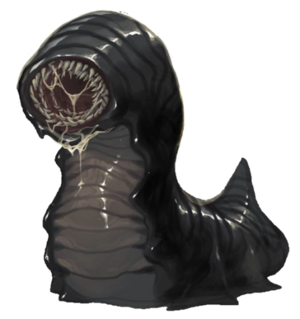- v50 information can now be added to pages in the main namespace. v0.47 information can still be found in the DF2014 namespace. See here for more details on the new versioning policy.
- Use this page to report any issues related to the migration.
Difference between revisions of "Giant leech"
m (Changed quality rating from "Unrated" to "Fine" using the rating script) |
m (Remove Migrated Tag) |
||
| (8 intermediate revisions by 6 users not shown) | |||
| Line 1: | Line 1: | ||
| − | {{Quality| | + | {{Quality|fine}} |
{{Creaturelookup/0 | {{Creaturelookup/0 | ||
| + | |image=giant_leech_sprite.png | ||
|meat=6 | |meat=6 | ||
|skin=hide | |skin=hide | ||
| Line 12: | Line 13: | ||
{{av}} | {{av}} | ||
{{creaturedesc}} | {{creaturedesc}} | ||
| − | + | '''Giant leeches''' are super-sized versions of the common [[leech]] who inhabit [[savage]] [[pool]]s and [[lake]]s. While their original counterparts are just [[vermin]], these [[creature]]s are over 3 times larger than a [[dwarf]]. They spawn individually and are not particularly aggressive, but are not benign and will attack other creatures (including dwarves) who provoke them, potentially killing them. However, due to their lack of [[bone]]s, they are fairly vulnerable to damage and can be killed rather easily. Being bitten by a giant leech may cause it to suck some [[blood]] out of the victim. | |
| + | |||
| + | Giant leeches can be captured in [[cage]] [[trap]]s and [[Animal trainer|trained]] into [[pet]]s, possessing the standard giant creature pet value. They are born adults and cannot be permanently tamed. Due to their lack of limbs, they produce very few products when [[butcher]]ed, making them a subpar choice for a [[meat industry]] despite being born instantly fully-sized. They are exotic [[mount]]s and may be witnessed being ridden by [[Elf|elves]] during [[siege]]s. | ||
| + | |||
| + | Some dwarves [[Preferences|like]] giant leeches for their ''feeding habits''. | ||
| + | [[File:giant_leech_preview.png|thumb|300px|center|'''Good news:''' It doesn't want blood.<br>'''Bad news:''' It wants more than that...]] | ||
{{gamedata}} | {{gamedata}} | ||
{{Creatures}} | {{Creatures}} | ||
Latest revision as of 17:50, 30 September 2024
|
L
| |
| Urist likes giant leeches for their feeding habits.
| |
|---|---|
| Biome | |
|
| |
| Variations | |
| Attributes | |
| Alignment: | Savage |
| Tamed Attributes | |
| Pet value | 500 |
|
| |
|
Not hunting/war trainable | |
| Size | |
| Max: | 200,700 cm3
|
| Age | |
| Adult at: | Birth |
| Max age: | 5-10 |
| Butchering returns | |
|
Food items | |
| Meat | 6 |
| Fat | 2 |
| Brain | 1 |
| Heart | 1 |
| Intestines | 1-2 |
|
Raw materials | |
| Skin | Raw hide |
v52.04 · v0.47.05 This article is about the current version of DF.Note that some content may still need to be updated. |
- A large monster in the shape of a leech.
Giant leeches are super-sized versions of the common leech who inhabit savage pools and lakes. While their original counterparts are just vermin, these creatures are over 3 times larger than a dwarf. They spawn individually and are not particularly aggressive, but are not benign and will attack other creatures (including dwarves) who provoke them, potentially killing them. However, due to their lack of bones, they are fairly vulnerable to damage and can be killed rather easily. Being bitten by a giant leech may cause it to suck some blood out of the victim.
Giant leeches can be captured in cage traps and trained into pets, possessing the standard giant creature pet value. They are born adults and cannot be permanently tamed. Due to their lack of limbs, they produce very few products when butchered, making them a subpar choice for a meat industry despite being born instantly fully-sized. They are exotic mounts and may be witnessed being ridden by elves during sieges.
Some dwarves like giant leeches for their feeding habits.
[CREATURE:GIANT_LEECH]
[COPY_TAGS_FROM:LEECH]
[APPLY_CREATURE_VARIATION:GIANT]
[CV_REMOVE_TAG:CHANGE_BODY_SIZE_PERC]
[APPLY_CURRENT_CREATURE_VARIATION]
[GO_TO_END]
[SELECT_CASTE:ALL]
[CHANGE_BODY_SIZE_PERC:200700]
[GO_TO_START]
[NAME:giant leech:giant leeches:giant leech]
[CASTE_NAME:giant leech:giant leeches:giant leech]
[DESCRIPTION:A large monster in the shape of a leech.]
[POPULATION_NUMBER:10:20]
[CLUSTER_NUMBER:1:1]
[CREATURE_TILE:'L']
[COLOR:0:0:1]
[PET_EXOTIC]
[PETVALUE:500]
[MOUNT_EXOTIC]
[GO_TO_END]
[PREFSTRING:feeding habits]
[APPLY_CREATURE_VARIATION:STANDARD_QUADRUPED_GAITS:900:657:438:219:1900:2900] 40 kph
[APPLY_CREATURE_VARIATION:STANDARD_SWIMMING_GAITS:2990:2257:1525:731:4300:6100] 12 kph
[APPLY_CREATURE_VARIATION:STANDARD_CRAWLING_GAITS:2990:2257:1525:731:4300:6100] |
